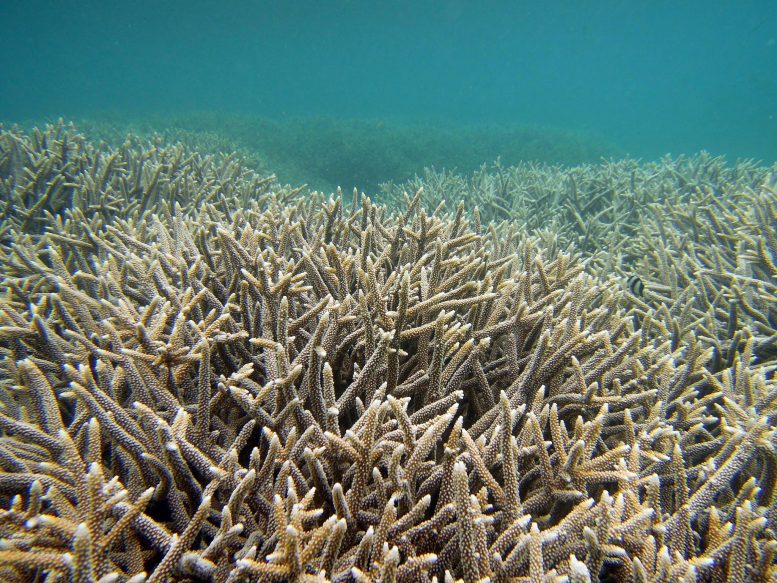
A healthy coral reef in 2012 in the Northern Mariana Islands. A year later, the reef was dead. The reef is a symbol of how climate change is already transforming ocean environments. Credit: Steven Mana‘oakamai Johnson
Climate change is altering familiar conditions of the world’s oceans and creating new environments that could undermine efforts to protect sea life in the world’s largest marine protected areas, new research from Oregon State University shows.
The changing conditions also have cultural and economic implications for the people whose traditions and livelihoods are dependent on ocean resources, said James Watson, an assistant professor in OSU’s College of Earth, Ocean, and Atmospheric Sciences and the paper’s co-author.
“What we’re looking at here is the potential extinction of a whole environment,” said Watson, who specializes in marine social-ecological systems and understanding complex adaptive systems. “In some places, the environments we have today are not going to exist in the future. We won’t be able to go visit them or experience them. It is an environmental, cultural and economic loss we can’t replace.”
The researchers’ analysis of multiple climate scenarios showed:
- 60% to 87% of the ocean is expected to experience multiple biological and chemical changes, such as increases in water temperature, higher levels of acidity and changes in oxygen levels, by the year 2060.
- The rate of change is expected to be even higher, 76% to 97%, in very large marine protected areas such as Australia’s Great Barrier Reef Marine Park and the Galapagos Marine Reserve in Ecuador.
- Increases in pH, which measures ocean acidity, are expected as soon as 2030. Ocean acidification reduces the amount of carbonate in seawater, which is necessary for marine organisms, such as corals and mollusks like oysters, to develop their shells and skeletons.
The findings were published recently in the journal One Earth. The paper’s lead author is Steven Mana‘oakamai Johnson, who conducted the research as part of his doctoral dissertation at Oregon State. Johnson, who earned his Ph.D. earlier this year, is now a postdoctoral researcher at Arizona State University.
The concept for the paper was borne from conversations between Johnson, a native of Saipan in the Northern Mariana Islands, a U.S. commonwealth in the Western Pacific Ocean, and Watson, a native of England, about what is likely to be lost due to climate change. One thing is the disappearance of ocean conditions they each experienced as children.
“All of us have experiences we define as normal under a given set of environmental conditions,” said Johnson, who is has already witnessed climate change impacts such as a devastating coral bleaching event in Saipan.
“Properties such as temperature, acidity, and oxygen levels define what a given part of the ocean looks like. For both James and me, the ocean experience we grew up with and have memories of will likely not exist for our grandchildren.”
Using the last 50 years of ocean conditions as a measure of stability, the researchers used several climate models to see how six variables affecting ocean conditions might change as the planet warms. They used three warming scenarios with increasing degrees of severity.
“Our scenarios included likely, unlikely, and highly unlikely degrees of warming, all of which are warmer today than they were 20 years ago,” Johnson said. “In all three scenarios, conditions in more than half of the ocean are going to be novel, meaning new and significantly different, than they have been in the last 50 years.”
Much of the change occurs in the ocean’s two extremes: the tropics and the Arctic. The warmest places are seeing warming conditions never seen before, and the coldest places, like the Arctic, are no longer as cold as they once were. The researchers also found that most of those changes will occur by 2060, though most of the change in pH, or acidity, levels is expected much sooner, by the end of the decade.
The change is more pronounced for the very large marine protected areas that are designed to preserve threatened species and rare habitats such as coral reefs around the world. As ocean conditions change, animals in those protected areas are likely to seek other locations that are more favorable for their survival.
“These marine protected areas are an important tool for achieving conservation goals and can take a lot of political and social will to establish and work as intended,” Johnson said. “In our analysis, 28 out of 29 of these areas will experience changes in conditions that could undermine conservation goals.”
The researchers’ findings present a picture of what the future might hold as the planet continues to warm, Johnson said. The research also offers important information to communities, policymakers, and managers of protected habitats about how changing ocean conditions might impact them and how they might address those changes.
“For example, tuna thrive in certain ocean conditions. If the ocean gets too warm, the tuna may move to another area,” Johnson said. “If your country depends on tuna for food or livelihood, what impact will that have?
“Or if you’re a manager of a protected area, and you’re protecting a species that is no longer in the area, what do you do?”
This type of forecasting advances how climate change is quantified, Watson said. It also gives people an opportunity to come to terms with the trauma of what is being lost as well as begin to make plans for a future without those resources.
“This kind of work has been done before for changes on land due to climate change, but not for the ocean,” he said. “It’s important to acknowledge and accept what were are likely to lose, and that loss can also help motivate people to begin to adapt.”
Reference: “Novel environmental conditions due to climate change in the world’s largest marine protected areas” by Steven Mana‘oakamai Johnson and James R. Watson, 11 November 2021, One Earth.
DOI: 10.1016/j.oneear.2021.10.016

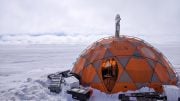
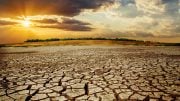
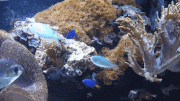
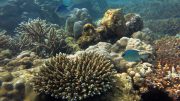
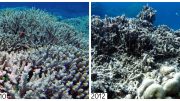

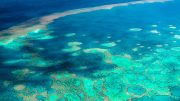
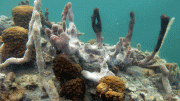
Yet another extremely poor piece of ‘research!’ It starts off with claiming that the alkaline oceans are going to become “more acidic.” In order to become “more,” something must already exist. An alkaline solution can be transformed into an acidic solution by the addition of a strong acid. However, stating that an alkaline solution may become “more” acidic is both grammatically incorrect and factually wrong. To compound the error, they state, “INCREASES in pH, which measures ocean acidity, [Actually, pH is the negative logarithm of the hydronium ion concentration.] are expected as soon as 2030.” He has it BACKWARDS! An increasing pH indicates a movement in the direction of alkalinity. It leaves me with the impression the he doesn’t really understand the pH scale and how pH is calculated. For readers with at least a background in high school chemistry, you might want to read the following:
https://co2coalition.org/wp-content/uploads/2021/11/2015-Cohen-Happer-Fundamentals-of-Ocean-pH.pdf
The authors express a concern about availability of carbonate for shell-building organisms. They are apparently unaware that in the warm, shallow waters of the Bahamas, calcium carbonate precipitates onto the ocean bottom, removing carbonate from the water. Yet, shell-building organisms have no problem finding adequate carbonate to flourish.
“’For example, tuna thrive in certain ocean conditions. If the ocean gets too warm, the tuna may move to another area,’ Johnson said. ‘If your country depends on tuna for food or livelihood, what impact will that have?’”
The Japanese, along with other countries, already have large fishing fleets off the coast of New Zealand. The impact? Probably business as usual.
For someone “who specializes in marine social-ecological systems and understanding complex adaptive systems,” I find it interesting that the focus is exclusively on temperature and temperature-dependent conditions. There is no mention of the role of plastic pollution, run-off of sediment and agricultural fertilizers and insecticides, or oil pollution. That seems quite myopic!
The ‘research’ being published in the field of climatology is abominable. Society needs to wake up to the politicization of this branch of science and demand corrective action before the world economies are destroyed by propagandists calling themselves scientists.
“Climate Change” is a natural process and does not require man made CO2 to function. It is mostly the function of our Sun which can scorch the Earth with Solar winds, deplete Ozone and cause Volcanoes to fill our atmosphere with CO2. The fact that a lot of “scientists” keep calling out people for emitting CO2 gas from driving gas powered vehicles proves that they are just State paid monkeys or exceptionally brainwashed individuals. This is the most ridiculous assertion ever, If you drive an electric car, where do think most electric power comes from, that’s right for coal or gas. It’s all Khazarian Deep State BS propaganda. China and India produce much, much more CO2 than the rest of the world combined but they don’t have to follow the Paris Climate accord because they are “poor” countries.
The Khazarian Deep State has been around for more than 6,000 years, they worship Satan and eat small children in Satanic rituals. There a lot of people that will laugh the previous statement off, if you are interested in the truth read the translations of Sumerian tablets.
We have been in an ice age called the Quaternary Glaciation for 2.588 million years. For over a million years we have been in an about 100,000-year cycle where we have an about 90,000-year cold glacial period where the Earth’s orbit is more of an ellipse with the sun at one focus receiving much less sunlight alternating with a warmer interglacial period that lasts about 10,000 years where the Earth’s orbit is closer to a circle and receiving much more sunlight. This interglacial cycle is called the Holocene and started about 11,700 years ago. Most of the US and northern Europe is too cold to live in during winter without warm clothes, shelter, and heating. We still have 190,000 glaciers that haven’t melted yet and whose melting would herald the end of the ice age that the Earth is in and true climate change.
Idiotic climate denialists still want to try and convince the public that the world really isn’t headed for disaster, which is obvious to even the most obtuse, but not the stupid. Interjection of conjecture, straw arguments and irrelevant utter nonsense does not support their claims and only proves the lable of “stupid”. Q-Anon clowns like “Tom”, arm-chair idiots like “Gardner”, denialists like “Spencer” want the reading public to accept their ludicrous claims and deny the body of science, evidence and established facts that dangerous changes are already well-underway. We can only wonder at what their personal agenda’s must be, but whatever they are, they are irrelevant. Earth changes are unfolding, do not respect any opinion, bias, ignorance or claim, and no matter what the denialists spew, it is obvious that they will continue to happen.
“… denialists like “Spencer” want the reading public to accept their ludicrous claims and deny the body of science …”
What I routinely do is point out mistakes of fact or logic, and expose when claims (such as yours) are not supported by evidence. If you think that my claims are “ludicrous” it would be more effective to demonstrate how or why I am wrong instead of insulting me. However, perhaps that is the best you can do to support your belief system. My personal agenda is to SUPPORT science by insisting that those claiming that they are doing the work of science present their evidence, particularly the empirical measurements, and demonstrate that they understand the vocabulary and concepts of basic physical science. You have given me no reason to believe that you really understand the Scientific Method.
Come back when you have something more substantive to share than insults.
“Obvious” is in the eye of the believer!
Incidentally, speaking of “stupid,” you misspelled “label.” Maybe you should turn on your spell checker.